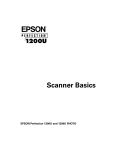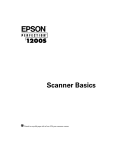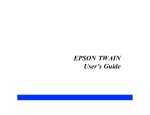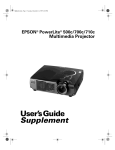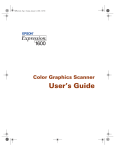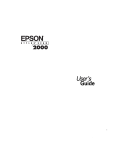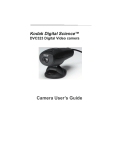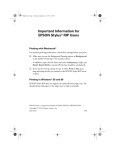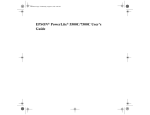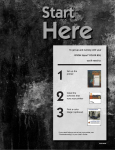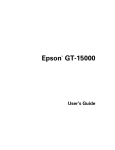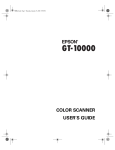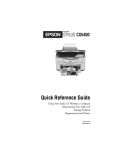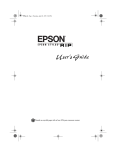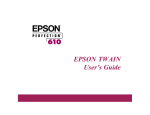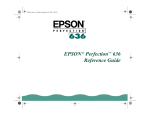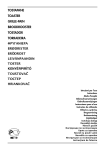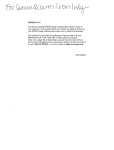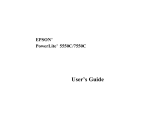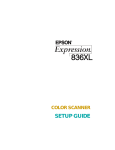Download Epson Perfection 610 Scanner Basic Guide
Transcript
basics.book Page i Wednesday, August 11, 1999 2:26 PM Scanner Basics basics.book Page ii Wednesday, August 11, 1999 2:26 PM Copyright Notice All rights reserved. No part of this publication may be reproduced, stored in a retrieval system, or transmitted in any form or by any means, electronic, mechanical, photocopying, recording, or otherwise, without the prior written permission of SEIKO EPSON CORPORATION. The information contained herein is designed only for use with this EPSON scanner. EPSON is not responsible for any use of this information as applied to other scanners. Neither SEIKO EPSON CORPORATION nor its affiliates shall be liable to the purchaser of this product or third parties for damages, losses, costs, or expenses incurred by purchaser or third parties as a result of: accident, misuse, or abuse of this product or unauthorized modifications, repairs, or alterations to this product, or (excluding the U.S.) failure to strictly comply with SEIKO EPSON CORPORATION’s operating and maintenance instructions. SEIKO EPSON CORPORATION shall not be liable for any damages or problems arising from the use of any options or any consumable products other than those designated as Original EPSON Products or EPSON Approved Products by SEIKO EPSON CORPORATION. A Note Concerning Responsible Use of Copyrighted Materials Digital cameras and scanners, like photocopiers and conventional scanners, can be misused by improper copying of copyrighted material. While some countries’ laws permit limited copying of copyrighted material in certain circumstances, those circumstances may not be as broad as some people assume. EPSON encourages each user to be responsible and respectful of the copyright laws when using digital cameras and scanners. Trademarks EPSON and EPSON Stylus are registered trademarks of SEIKO EPSON CORPORATION. EPSON SoundAdvice is a service mark, ColorTrue is a registered trademark, and Perfection, Micro Step Drive, and EPSON FaxAdvice are trademarks of Epson America, Inc. General Notice: Other product names used herein are for identification purposes only and may be trademarks of their respective owners. EPSON disclaims any and all rights in those marks. Copyright © 1999 by Epson America, Inc. Printed on recycled paper with at least 10% post-consumer content. CPD 8876 8/99 basics.book Page i Wednesday, August 11, 1999 2:26 PM Contents A COMPLETE SCANNING SOLUTION 1 About Your Scanner About Your Software About Your Documentation Cautions, Notes, and Tips System Requirements Windows 98 Macintosh Year 2000 Ready ENERGY STAR Compliance Important Safety Instructions 1 2 2 3 3 3 4 5 5 5 SETTING UP YOUR SCANNER 7 Unpack Your Scanner Choose a Good Place for Your Scanner Unlock the Scanner Connect the Scanner to Your Computer Power On Your System Install the Scanner Software If You’re Running Windows 98 . . . If You’re Using a Macintosh . . . Install the Creative Software and Electronic Manuals 7 8 9 10 10 11 11 14 16 i basics.book Page ii Wednesday, August 11, 1999 2:26 PM ii VIEWING YOUR ELECTRONIC MANUALS 19 Copying a Manual to Your Hard Drive Navigating a Manual 19 20 HOW TO SCAN 21 Preparing to Scan Selecting Your Application for Scanning Step-by-Step Scanning Instructions Place Your Original Document Scan a Photograph with PictureWorks HotShots and EPSON TWAIN Selecting Settings Using Marquees Adjusting a Marquee Tips for Getting the Best Scan Selecting Resolution Scanning Something That Doesn’t Fit Under the Document Cover 21 21 22 22 23 24 26 27 27 27 29 START BUTTON SCANNING 31 Preparing to Use the Start Button Creating an Illustrated Document 31 32 WORKING WITH SCANNED PHOTOS 37 Opening a Picture and Placing It In a Collection Open the Picture Open or Create a Collection Add Pictures to the Collection Delete Pictures From the Collection Correcting Images Using Quick Fix Using SmartPix Using Fix by Example 37 37 38 38 39 39 39 40 42 basics.book Page iii Wednesday, August 11, 1999 2:26 PM Printing Creating a Photo Page Printing Your Image or Photo Page Adding Your Image to a Document Importing Images Into Documents Getting Images With Copy and Paste Using Drag and Drop From a Collection 43 44 45 46 46 47 48 SCANNER MAINTENANCE 51 Transporting the Scanner Cleaning the Scanner 51 52 PROBLEMS? NEED HELP? 53 Identifying Scanner Parts Scanner Lamp Error Indication Problem Solving Operating Problems Setup Problems Scanner Problems Software Problems Scanning Problems Where To Get Help EPSON Technical Support Software Technical Support 53 54 54 54 55 55 56 58 63 63 64 SCANNER SPECIFICATIONS 65 INDEX 71 iii basics.book Page 1 Wednesday, August 11, 1999 2:26 PM A Complete Scanning Solution Your EPSON® Perfection™ 610 scanner is a high-quality scanner packed with easy-to-use features for scanning—for business, home, or school. The “plug & play” USB connection is fast and easy with no extra hardware to install. Using EPSON’s ColorTrue® Imaging System, the scanner captures your images with amazing detail and accurate colors. Your scanner can achieve up to 600 × 2400 dpi hardware resolution with EPSON’s proprietary Micro Step Drive™ technology, delivering crisp, precise images. About Your Scanner Your EPSON Perfection 610 scanner includes the following features: ■ Superior image quality: ■ True optical resolution of 600 dots per inch (dpi) ■ Hardware resolution of 600 × 2400 dpi with Micro Step Drive technology ■ Maximum resolution of 9600 × 9600 dpi with interpolation ■ Start button for easy, one-touch scanning ■ EPSON TWAIN for accurate, high speed scanning ■ Letter/A4 size scanning area ■ Self-adjusting lid that allows scanning of thick documents 1 basics.book Page 2 Wednesday, August 11, 1999 2:26 PM About Your Software The EPSON Perfection 610 scanner includes these applications for great looking scans: EPSON TWAIN Driver The scanning utility for producing professional quality images. Ideal for scanning text into OCR programs. PictureWorks™ HotShots™ Use this digital imaging software to get your images from the scanner and organize them right away. Then enhance your images, add special effects, and share them with photo templates and printouts. BrØderbund ® The Print Shop® PressWriter™ Use the built-in templates to easily and quickly create professional newsletters, brochures, resumes, and flyers. NewSoft ™ Presto! ™ PageManager for EPSON Use with the scanner’s Start button feature to quickly scan documents. Then drag and drop your scanned images into almost any application. Or convert scanned text into editable documents using the built-in OCR software. About Your Documentation This guide includes instructions for setting up your scanner, scanning tips, and troubleshooting advice. It also includes instructions for viewing your electronic manual. For details on using the scanner software, see your electronic EPSON TWAIN User’s Guide. 2 basics.book Page 3 Wednesday, August 11, 1999 2:26 PM Cautions, Notes, and Tips Please follow these guidelines as you read your documentation: Cautions must be observed to avoid damage to your equipment. Notes contain important information about your scanner. Tips contain hints for great scanning. System Requirements The minimum system requirements for Windows and Macintosh are listed below. For optimum performance, a faster processor and more memory are recommended. If you are scanning high resolution images, you need more than the minimum available hard disk space listed. Windows 98 ■ An IBM® compatible PC with a 486/66 MHz or faster processor ■ Microsoft® Windows 98 preinstalled ■ 16MB RAM (32MB recommended) ■ 50MB available hard disk space ■ Available USB port or hub connection 3 basics.book Page 4 Wednesday, August 11, 1999 2:26 PM ■ CD-ROM drive ■ Mouse or pointing device ■ VGA or higher resolution monitor with 640 × 480 resolution (800 × 600 or higher recommended) and 256 colors (65,000 colors or more recommended) Color and tone reproduction are subject to the display capability of your computer system, including the video card, monitor, and software. See the documentation for these products for details. Macintosh You cannot use a serial interface to connect the scanner. ■ Apple® Macintosh® computer (G3 or iMac™) running Mac® OS 8.1, or Mac OS 8.5 or later If you are using Mac OS 8.1 on an iMac, you need to install iMac Firmware Update 1.0 before installing the scanner software. This is available online from the Apple web site. If you are using Mac OS 8.5, check the Apple web site for any updates. ■ Available USB port or hub connection ■ 32MB RAM (64MB recommended) ■ 50MB available hard disk space ■ CD-ROM drive ■ Mouse or pointing device ■ VGA color monitor with 640 × 480 screen resolution (or higher recommended) and 256 colors (32,000 colors or more recommended) Color and tone reproduction are subject to the display capability of your computer system, including the video card, monitor, and software. See the documentation for these products for details. 4 basics.book Page 5 Wednesday, August 11, 1999 2:26 PM EPSON TWAIN supports the Apple ColorSync™ 2.X color management system and QuickTime.™ These extensions are automatically installed during EPSON TWAIN installation. Year 2000 Ready Your EPSON scanner is Year 2000 Ready. However, be sure the other parts of your computer system are also ready for the year 2000. ENERGY STAR Compliance As an ENERGY STAR Partner, EPSON has determined that this product meets the ENERGY STAR guidelines for energy efficiency. The EPA ENERGY STAR office equipment program is a voluntary partnership with the computer and office equipment industry to promote the introduction of energy-efficient personal computers, monitors, printers, fax machines, and copiers in an effort to reduce air pollution caused by power generation. Important Safety Instructions Read all of these instructions and save them for later reference. Follow all warnings and instructions marked on the scanner. ■ Unplug the scanner before cleaning. Clean with a damp cloth only. Do not spill liquid on the scanner. ■ Do not place the scanner on an unstable surface or near a radiator or heat source. ■ Do not block or cover the openings in the scanner’s cabinet. Do not insert objects through the slots. 5 basics.book Page 6 Wednesday, August 11, 1999 2:26 PM ■ Use only the type of power source indicated on the scanner’s label. ■ Connect all equipment to properly grounded power outlets. Avoid using outlets on the same circuit as photocopiers or air control systems that regularly switch on and off. ■ Do not let the power cord become damaged or frayed. ■ Unplug the power cord if you will not be using the scanner for an extended period of time. ■ If you use an extension cord with the scanner, make sure the total ampere rating of the devices plugged into the extension cord does not exceed the cord’s ampere rating. Also, make sure the total ampere rating of all devices plugged into the wall outlet does not exceed the wall outlet’s ampere rating. ■ Do not attempt to service the scanner yourself. ■ Unplug the scanner and refer servicing to qualified service personnel under the following conditions: If the power cord or plug is damaged; if liquid has entered the scanner; if the scanner has been dropped or the cabinet damaged; if the scanner does not operate normally or exhibits a distinct change in performance. Do not adjust controls that are not covered by the operating instructions. 6 basics.book Page 7 Wednesday, August 11, 1999 2:26 PM Setting Up Your Scanner Setting up your scanner is easy—just follow the simple steps in this book in the order listed below. 1. Unpack and choose a place for your scanner. 2. Unlock the scanner. 3. Connect the scanner to your computer. 4. Power on your system. 5. Install the scanner software. 6. Install the creative software and view your electronic manuals. Unpack Your Scanner Remove the scanner from the box, then remove the packing material from your scanner. Save the packaging in case you need it later. Your EPSON Perfection 610 comes with this Scanner Basics book and the items shown below. scanner USB interface cable CD-ROM with driver, electronic manuals, and creative software 7 basics.book Page 8 Wednesday, August 11, 1999 2:26 PM Choose a Good Place for Your Scanner Here are some points to consider: ■ Place the scanner on a flat, stable surface. If the scanner is tilted, it can’t operate properly. ■ Make sure to place the scanner where you can easily unplug the power cord, and where the USB cable can reach your computer. ■ Keep the scanner away from direct sunlight and strong light sources. ■ Avoid places subject to shocks and vibrations, or high or rapidly changing temperatures and humidity. ■ Be sure there’s enough room behind the scanner for the cables, and above the scanner so you can fully raise the document cover. 18.9 inches (48.0 cm) when document cover is open 3.5 inches (8.8 cm) when document cover is closed 11.3 inches (28.7 cm) 8 at least 3.9 inches (10.0 cm) 16.7 inches (42.5 cm) basics.book Page 9 Wednesday, August 11, 1999 2:26 PM Unlock the Scanner Before connecting the scanner to a power source, you must release the transportation lock, located on the side of the scanner. Turn the transportation lock down to the unlocked position using a coin or similar object, as shown. If you can’t turn the transportation lock easily, plug the scanner in; then, after a minute, unplug the scanner and try again. Always lock the scanner carriage before transporting it; otherwise, the scanner may be damaged. Be sure the scanner lamp is in the home position (toward the back of the scanner). To ensure this, always unplug the scanner before locking the carriage. home position 9 basics.book Page 10 Wednesday, August 11, 1999 2:26 PM Connect the Scanner to Your Computer If you are connecting to a PC, Windows 98 must be preinstalled on your system. 1. Make sure the scanner is unplugged, and the computer and any USB devices connected to your computer are turned off. 2. Locate the USB cable that came with your scanner. 3. Plug the square connector on the USB cable into the USB connector on the back of the scanner. Then plug the flat connector into the USB port on your computer or USB hub. Your system may not work correctly if you use a USB cable other than the one supplied by EPSON or if you connect your scanner through more than one hub. Power On Your System Plug in your scanner before you turn on the computer. Otherwise, the computer may not recognize your EPSON scanner when you install your software. (The scanner lamp turns on when it is plugged in, but goes into sleep mode when it has not been used for ten minutes. The lamp comes back on when you scan.) It is recommended that you unplug your scanner when you are not using it. 10 basics.book Page 11 Wednesday, August 11, 1999 2:26 PM Install the Scanner Software The scanner software comes on one CD-ROM for both Windows 98 and Macintosh. If You’re Running Windows 98 . . . You may be asked to insert your Windows 98 operating system CD-ROM during the scanner installation. Have your Windows CD-ROM handy, in case you need it. 1. Make sure your scanner is plugged in to a power source and connected to the computer; then turn on your computer. A screen appears saying that your system has detected new hardware. Then the Add New Hardware Wizard screen appears. 2. Insert the scanner software CD-ROM in the CD-ROM drive, then click Next. 3. Select the Search for the best driver for your device option, then click Next. 11 basics.book Page 12 Wednesday, August 11, 1999 2:26 PM 4. Make sure only the CD-ROM drive check box is selected, then click Next. 5. Click Next to continue with the driver installation. 6. After the scanner software installation is complete, the EPSON Screen Calibration utility automatically starts. You must calibrate your screen and scanner to reproduce images closely matching the originals. You don’t need to change the screen calibration again so long as you continue to use the same monitor. If you need to recalibrate your screen at a later time, click Scanners and Cameras in the Control Panel. On the Devices tab, select Scanner. Click Properties, then click the Calibration button. 12 basics.book Page 13 Wednesday, August 11, 1999 2:26 PM In the following window, move the slider to the right or left until the shades of the horizontal gray stripes appear similar. View the screen from a short distance. The gray stripes will not perfectly blend together; however, try to make the two tones match as closely as possible. before calibration after calibration 7. Click OK to register the calibration setting. 8. Click Finish to exit the Add New Hardware Wizard. You will find the Scanners and Cameras icon in the Control Panel after EPSON TWAIN is installed. 9. Now you can install your creative software and view your electronic manuals as described on page 16. 13 basics.book Page 14 Wednesday, August 11, 1999 2:26 PM If You’re Using a Macintosh . . . If you are using Mac OS 8.1, you need to install the Macintosh Update before installing the scanner software. This is available online from the Apple web site. If you are using Mac OS 8.5 or later, check the Apple web site for any updates. 1. Make sure your scanner is plugged in to a power source and connected to the computer. Then turn on your Macintosh and turn off any virus protection programs. If you see the following message, click OK and continue with step 2. 2. Insert the scanner software CD-ROM in the CD-ROM drive. Double-click the EPSON CD-ROM icon to open it. 3. Double-click the EPSON TWAIN L Installer icon. 4. The EPSON screen and software License Agreement screen appear. After reading the license agreement, click AGREE to continue with the installation. 5. When the Scanner Software Installation screen appears, click Install. 6. When the EPSON TWAIN Installer screen appears, click Install for the default installation. 14 basics.book Page 15 Wednesday, August 11, 1999 2:26 PM 7. When the scanner software installation is complete, you see this screen: Click Quit. The Screen Calibration utility starts. You must calibrate your screen and scanner to reproduce images closely matching the originals. 8. In the following window, move the slider to the right or left until the shades of the horizontal gray stripes appear similar. View the screen from a short distance. The gray stripes will not perfectly blend together; however, try to make the two tones match as closely as possible. before calibration after calibration 9. Click OK to register the calibration setting. Then restart your Macintosh. You will not need to change the screen calibration again as long as you continue to use the same monitor. If you need to recalibrate your screen at a later time, select Screen Calibration in the EPSON Scanner folder. 10. Now you can install your creative software and view your electronic manuals as described below. 15 basics.book Page 16 Wednesday, August 11, 1999 2:26 PM Install the Creative Software and Electronic Manuals Before you begin, Be sure any virus protection programs are turned off. Follow these steps: 1. Insert the scanner software CD-ROM in your CD-ROM drive. 2. Windows: Double-click My Computer, then double-click the CD-ROM icon. The CD-ROM window opens. Double-click EPSON.exe. Macintosh: Double-click the EPSON CD-ROM icon to open it, if necessary, then double-click the EPSON icon. 3. The EPSON screen and software License Agreement screen appear. After reading the license agreement, click AGREE to continue with the installation. The Main Menu appears on your screen. 16 basics.book Page 17 Wednesday, August 11, 1999 2:26 PM 4. Click Creative Software. The Creative Software screen appears. 5. Click the application name or button for the program you want to install. The install screen appears for the application you selected (the example shown is for PictureWorks HotShots.) 6. Click the Install text to install the selected software. (You can skip the installation by clicking the BACK button at the bottom of the window.) 7. If the application requires a restart, go back to step 2 after restarting to install another application. If the application does not require a restart, you return to the Creative Software screen. Select another application to install or click BACK to return to the Main Menu. 8. After you install your applications you can view and install your electronic manuals. At the Main Menu, click Electronic Documentation. 9. On the Electronic Documentation screen, click the name of the manual you want to view. If you don’t have Adobe Acrobat Reader 4.0 or 3.0 installed, you have the option to install it from the CD-ROM. For more information, see “Viewing Your Electronic Manuals” on page 19. 10. If you install Acrobat Reader on your Macintosh, you need to restart the EPSON computer. To get back to the Main Menu, double-click the Installer icon. 17 basics.book Page 18 Wednesday, August 11, 1999 2:26 PM 11. After viewing an electronic manual, close Acrobat Reader and click the Electronic Documentation window to highlight it. You can select another manual to view, click BACK to return to the Main Menu, or click QUIT or EXIT to quit the installer. If any of the software you installed requires a restart and you did not restart when you installed the software, you should restart your computer now. 18 basics.book Page 19 Wednesday, August 11, 1999 2:26 PM Viewing Your Electronic Manuals You always have easy access to your electronic manuals—just go to the Main Menu screen on your scanner software CD-ROM and click Electronic Documentation. If you already have Adobe Acrobat Reader (version 3.0 or later) on your system, the manual opens in Acrobat Reader automatically. If you don’t have Acrobat Reader, it is automatically installed from the CD-ROM and then the manual you selected opens. Your scanner software CD-ROM includes the following manuals: ■ EPSON TWAIN User’s Guide (TWAIN.pdf) ■ PictureWorks HotShots User’s Guide (HotShots.pdf) ■ NewSoft Presto! PageManager User’s Guide (PageManager.pdf) ■ BrØderbund The Print Shop PressWriter User’s Guide (PressWriter.pdf) For guidelines on viewing your electronic manuals using Acrobat Reader, see “Navigating a Manual” on the next page. Copying a Manual to Your Hard Drive If you prefer to view the electronic manuals from your hard drive instead of the CD-ROM, you can copy them from the Manuals folder, located in the Browser folder on the CD-ROM. The file names are listed above. The manuals for some software applications are automatically copied to your hard drive when you install the software. You can access these manuals by clicking Start, Programs, the program name, then the manual name. 19 basics.book Page 20 Wednesday, August 11, 1999 2:26 PM Navigating a Manual When you open an electronic manual, you’ll see this toolbar: previous page next page first page last page show bookmarks and page The toolbar for Acrobat Reader 3.0 looks slightly different. With Acrobat Reader, you have several ways to navigate through text: ■ Click on hot topics, which are usually underlined or displayed in a different color. To find out if a topic is hot, move your cursor over it. If the cursor turns into a pointing hand, the topic is hot—you can jump to it by clicking once. ■ Use the bookmark section on the left side of the screen to move quickly to the topic of your choice. Click the Show Bookmarks icon on the toolbar to see the bookmark section, if the manual has bookmarks. Some manuals only have a table of contents, but you can also use this to navigate the manual if the topics are hot. ■ Use the arrow buttons in the toolbar or the vertical scroll bar on the right side of the document to move through a manual. (The box to the left of the scroll bar displays the current page number.) For more information, see your Acrobat Reader online guide. 20 basics.book Page 21 Wednesday, August 11, 1999 2:26 PM How to Scan This section gives you an overview of the scanning process and some tips for getting the best scan. It also includes step-by-step scanning instructions. Preparing to Scan Scanning an image allows you to reproduce it many times with little or no loss of quality. You can also enlarge, reduce, or change the color of the image without affecting your original. Scans are performed from within a host application (the application into which you plan to import the scanned image or document, such as PictureWorks HotShots). You have to start this application before you can access your scanner software. Once you’ve started your application, you need to select the scanner “source” you want to scan with. Your EPSON Perfection 610 scanner comes with the EPSON TWAIN driver. You need to select this driver as the source in your application. Selecting Your Application for Scanning You need to select the appropriate application for what you are scanning. Some examples of scans are shown in the following table. Image type Recommended application Photograph HotShots Small photograph to be enlarged HotShots Magazine HotShots Newspaper (text only) PageManager Text for OCR PageManager Text with images (not for OCR) HotShots Line art HotShots 21 basics.book Page 22 Wednesday, August 11, 1999 2:26 PM Step-by-Step Scanning Instructions This section contains step-by-step instructions for using the scanner drivers and creative software in Windows 98 and Macintosh. For more details on using the scanner software, see the EPSON TWAIN User’s Guide on your CD-ROM. For instructions on using the creative software, see your application’s online help or electronic manual (see “Viewing Your Electronic Manuals” on page 19). If your computer fails to recognize the scanner, you won’t see the EPSON TWAIN driver when you try to select a scanner source from your host application. In addition, an error message may appear. If this happens, unplug your scanner and then plug it back in. Then restart the computer. Do not connect or disconnect the USB cable while you are using EPSON TWAIN. Place Your Original Document 1. Raise the scanner cover and place your document face down on the document table glass. corner of the document 2. Position the document so the horizontal and vertical edges are carefully aligned with the scales on the top and right side of the document table. 3. Close the document cover slowly. Be careful not to move the document. An area of 0.12 inches (3 mm) in from the horizontal and vertical guides is not scanned. The self-adjusting scanner cover allows you to place thick documents on the document table glass without removing it. If your document is too thick to fit under the cover, you can remove the cover as described on page 29. 22 basics.book Page 23 Wednesday, August 11, 1999 2:26 PM Scan a Photograph with PictureWorks HotShots and EPSON TWAIN This example explains how to scan a photograph using the EPSON TWAIN scanner driver and PictureWorks HotShots. To scan an OCR document using the Start button and Presto! PageManager, see “Start Button Scanning” on page 31. For additional information on how to use EPSON TWAIN, see the electronic EPSON TWAIN User’s Guide. Make sure you have placed your document as described above and your computer is turned on, then: 1. Click Start, point to Programs and PictureWorks, then click HotShots 1.5. 2. Select your scanner source and open the scanner software (EPSON TWAIN): a. Click the Get button. b. Select Get from Scanner. Get button c. Click the Select Scanner menu. d. Select EPSON TWAIN L from the list. e. Click Get Pictures Now. f. Select Open Them, Add to New Collection, or Add to Existing Collection from the Get Pictures dialog box. 3. Make the appropriate setting selections for your scan. (See page 24 for details.) 4. Preview your scan. You see a preview of your scan in the preview area on the right side of your screen. (You may need to click Preview to update the image.) 5. Draw a marquee around the part of the image you want to scan. Make sure you draw a marquee around only the part of the image you want to scan, especially if you are scanning at resolutions of 300 dpi or greater. See page 26 for details. 6. Make the changes you want to adjust the image, then click the Scan button to scan your image. 23 basics.book Page 24 Wednesday, August 11, 1999 2:26 PM In a few moments, the scanned image is imported into PictureWorks HotShots. You must close EPSON TWAIN to view the image in the application window. Don’t leave documents, especially photographs, on the document table for long periods of time. They may stick to the glass or deteriorate from the warmth of the scanner. Selecting Settings For Photographs If you are scanning a photograph or images other than line art or text, you should scan using the Photo tab. You should also use this tab for pages with both text and photos. Select from the settings below: 24 ■ Image Type: Color Photo, Black & White Photo ■ Resolution: 75, 150, 300, 600, 1200, 2400 ■ Color Management: Speed, Quality basics.book Page 25 Wednesday, August 11, 1999 2:26 PM ■ Effect: Unsharp Mask, Descreening For Line Art and Text If you are scanning line art or text, you should scan using the OCR/Line Art tab. Select from the settings below: ■ Resolution: 300, 600 ■ Threshold: User Defined, Newspaper, Magazine, Printout, Book If you are scanning text for OCR, you should use PageManager. See page 31 for a step-by-step example of how to use the Start Button, PageManager, and HotShots to create an illustrated, editable document. For more information on EPSON TWAIN and PageManager, see your electronic EPSON TWAIN User’s Guide. 25 basics.book Page 26 Wednesday, August 11, 1999 2:26 PM Using Marquees A marquee is a frame around an entire image, or a portion of an image so you can scan only the most important part. To create a marquee, follow these steps: 1. Move the mouse pointer over the preview image; the pointer becomes a cross hair. If the mouse pointer doesn’t change to a cross hair, click the Preview button again. 2. Position the pointer in the corner of the area you want to select and press the mouse button. 3. Hold down the mouse button as you drag the mouse across the image, creating a marquee. marquee 4. Release the button when the marquee contains the image area you want. 5. When you’re ready to scan, click the Scan button. The scanned image appears in your application window. If you need to adjust the marquee size or position, or delete the marquee, see page 27. 26 basics.book Page 27 Wednesday, August 11, 1999 2:26 PM Adjusting a Marquee To resize a marquee, place the mouse pointer over its edge; the pointer changes to a double-headed arrow. Click the mouse button and drag the box up, down, sideways, or diagonally to the size you want. To resize a marquee and retain its width-to-height proportions, hold down the Shift key as you drag the edge of the marquee. To move a marquee, place the mouse pointer anywhere in the marquee image area; the pointer changes to a hand. Click the mouse button and drag the entire marquee to move it where you want it. To delete a marquee, click outside the marquee area. Tips for Getting the Best Scan Getting the best scan possible depends on several factors, including the quality of your original and the resolution you select. The better your original is, the better your scan will be. While you can make some corrections in your scanning software, you’ll need to do major photo retouching in a program such as PictureWorks HotShots to correct or mask problems such as a coffee stain on the original image. Selecting Resolution Resolution refers to how many dots per inch (dpi) or dots per centimeter (dpcm) your image contains. The best resolution for a scanned image depends on the type of image you’re scanning and your final output device. As a rule of thumb for most images except line art, use a scanning resolution that is approximately one third of your output resolution. For example, use a scanning resolution up to 100 dpi with a 300 dpi laser printer, and up to 200 dpi with a 27 basics.book Page 28 Wednesday, August 11, 1999 2:26 PM 600 dpi laser printer. For 1440 dpi ink jet printers, such as the EPSON Stylus® COLOR or Photo series, use a scanning resolution of approximately 300 dpi. Try a scanning resolution of 240 dpi for 720 dpi printing. Keep the following in mind when you choose a resolution: ■ The higher a resolution you select, the larger the resulting image file will be. For example, an 8.5 × 11-inch original scanned at 300 dpi can produce a 24MB file. The same original scanned at 72 dpi creates only a 1.3MB file. To keep your file size manageable, select the lowest possible resolution that gives acceptable quality. ■ If you need to scan at a higher resolution, you can reduce the size of the image file by scanning only part of the image. For information about selecting part of an image, see “Using Marquees” on page 26. ■ If you will be enlarging a file in your image editing software, scan at a higher resolution to maintain the image quality. The EPSON Perfection 610’s maximum hardware resolution of 600 × 2400 dpi is achieved through EPSON’s advanced Micro Step Drive technology. This technology enables the EPSON Perfection 610 to achieve a maximum sub-scan or vertical resolution of 1200 dpi or 2400 dpi using “half-stepping” and “quarter-stepping” of the scanning carriage to double and quadruple the optical resolution. To prevent enormous file sizes when scanning at the maximum hardware resolution, EPSON recommends a maximum scan window of 4 × 11.7 inches. Full 8.5 × 11.7 inch scanning is available at a sub-scan resolution of 1200 dpi or 9600 dpi interpolated. 28 basics.book Page 29 Wednesday, August 11, 1999 2:26 PM Scanning Something That Doesn’t Fit Under the Document Cover The self-adjusting scanner cover allows you to place thick documents on the document table glass without removing the cover. If your document is too thick to fit under the cover— such as a photo in an album—you can remove the document cover. To do this, simply lift the back of the document cover straight up. When scanning with the cover removed, make sure no area of the document table is exposed. This prevents interference from external light. When reattaching the document cover, be sure to hold the cover so the hinges are in a vertical position. Then push straight down until the cover clicks into place. 29 basics.book Page 30 Wednesday, August 11, 1999 2:26 PM 30 basics.book Page 31 Wednesday, August 11, 1999 2:26 PM Start Button Scanning The scanner’s Start button lets you set up your system for one-touch scanning with Presto! PageManager and a scanner monitoring utility. With one-touch scanning, you can load a document in the scanner, press the Start button, and watch while PageManager starts and then opens EPSON TWAIN automatically. This chapter includes a scan project that demonstrates how to: ■ Use the Start button for quick scanning ■ Run drag-and-drop OCR with PageManager and your word processing application ■ Drag-and-drop an image from your imaging software into the document Preparing to Use the Start Button To use the Start button, you must have installed PageManager (see page 16). With Windows 98, you can also use other programs that support linking to scanner events with the Start button, such as Adobe® Photoshop® 5.0 and Windows Imaging. If you want to configure specific settings for Start button scanning, see your electronic EPSON TWAIN User’s Guide. When you’re ready to use the Start button, follow the instructions in “Creating an Illustrated Document” on page 32. 31 basics.book Page 32 Wednesday, August 11, 1999 2:26 PM Creating an Illustrated Document This section gives an example of how to use the Start button to scan a document, use the PageManager OCR (optical character recognition) engine to convert it to an editable document in your word processor, and then drag in a scanned image into your document. The steps use Microsoft Word, but you can use any OCR-compliant program. The example also uses PictureWorks HotShots; see page 16 for installation. Follow these steps to create a simple illustrated document: 1. Place the document face down and align its horizontal and vertical edges with the scales on the top and right side of the document table. 2. Press the scanner’s Start button. Start button 32 basics.book Page 33 Wednesday, August 11, 1999 2:26 PM 3. In Windows, if you’ve selected more than one application to use with the Start button in the Scan Events utility, you see this dialog box: For instructions on changing the applications available for use with the Start button, see your electronic EPSON TWAIN User’s Guide. 4. Click Presto! PageManager for EPSON and click OK. (If the dialog box disappears before you select an application, press the scanner’s Start button again.) If PageManager wasn’t running when you pressed the Start button, it starts on your system. The EPSON TWAIN window opens in PageManager, along with the Scan Buttons bar. 33 basics.book Page 34 Wednesday, August 11, 1999 2:26 PM 5. To scan a document for an OCR application, select the OCR/Line Art tab. (See page 24 for other TWAIN settings you may want to select.) 6. Click the Scan button to scan your document. When scanning is finished, click the Close button to close the EPSON TWAIN window. 7. Click the Inbox icon to view the image icons in PageManager. click the inbox icon to view thumbnails selected image thumbnail click and drag the image thumbnail to your application’s icon 34 basics.book Page 35 Wednesday, August 11, 1999 2:26 PM 8. Drag the thumbnail of the image from the main window to your application’s icon on the application bar. The OCR window opens, showing the progress of the translation. When the text is converted, the application automatically opens with your new file. 9. Save the new file in your application and close PageManager. 10. Open PictureWorks HotShots and then open an image or collection. (If you want, scan a new image following steps 1 to 9 above, selecting the Photo tab in step 5 and dragging the file to the HotShots icon in step 8.) 35 basics.book Page 36 Wednesday, August 11, 1999 2:26 PM 11. Arrange the window for HotShots so it is next to the window for your application. 12. Click the image you want to copy from the HotShots collection, or click the gray bar at the top of your open image. 13. While holding down the mouse button, drag the image to the location where you want it in your document. 14. Release the mouse button. The picture appears in your document in the other application. You can also configure your system and PageManager to automatically launch an application and scan directly into it using the Start button. See your EPSON TWAIN User’s Guide for more information. 36 basics.book Page 37 Wednesday, August 11, 1999 2:26 PM Working With Scanned Photos This chapter steps you through what you can do with your image once you have scanned it into your computer using PictureWorks HotShots. The following information is covered in this chapter: ■ Opening an image and placing it in a collection ■ Correcting images ■ Printing ■ Adding your image to a document Opening a Picture and Placing It In a Collection You may have saved your picture in a HotShots collection when you scanned it. If you didn’t, or if you want to save it in a different collection, follow these steps to open your picture and create a new collection: Open the Picture Get button 1. Open HotShots and click the Get button on the remote control. 2. Select Get from Disk and click the Open a Picture button. (You can also select Open Picture from the File menu.) 3. You see the Open dialog box. Highlight the picture name and click Open. Your picture opens in a window. 37 basics.book Page 38 Wednesday, August 11, 1999 2:26 PM Open or Create a Collection 1. Click the Get button on the remote control. 2. Click Get from Disk and click the Open a Collection or Create a Collection button. 3. You see the Open dialog box. Highlight an existing collection and click Open, or click Empty to open a new collection. Your collection window opens. Add Pictures to the Collection There are two ways to add pictures to your collection: drag-and-drop or the Add button. To drag and drop a picture into a collection, open the picture and collection, as described in the previous sections. Then click the gray grab bar on the picture, drag it to the collection window, and release the mouse button. The picture appears in the collection window. Click the gray grab bar, then drag it to the collection window Add button To add an unopened picture, click the Add button on the taskbar in the collection window. You see the Add to Collection dialog box. Select the picture you want to add and click Add (Windows) or Open (Macintosh). The picture appears in the collection window. 38 basics.book Page 39 Wednesday, August 11, 1999 2:26 PM Delete Pictures From the Collection To delete a picture from a collection, click it; a green line appears around the picture. To select multiple pictures for deletion, hold down the Ctrl (Windows only) or Shift key as you click the pictures. Then click the Delete button. You see a confirmation message; click Yes. Click the Delete button to delete an image Selected image Correcting Images The following sections describe three ways you can optimize your image quality in HotShots: ■ Using Quick Fix ■ Using SmartPix ■ Using Fix by Example Using Quick Fix The easiest way to enhance your image is to use HotShot’s Quick Fix command to automatically adjust it. Quick Fix gives you clearer, brighter images while maintaining the highlight and shadow detail. However, if your original image has intense highlights or shadows, it’s better to adjust it using Fix by Example, as described on page 42. 39 basics.book Page 40 Wednesday, August 11, 1999 2:26 PM Follow these steps to use Quick Fix: 1. Open the picture you want to edit. See page 37 for instructions. 2. Click the Enhance button on the remote control to open the Enhance menu. Enhance button 3. Click Quick Fix. The picture in the window is modified to reflect your changes. (You can zoom into the image to see the changes more clearly; click Zoom In from the Image menu.) If you change your mind about the edit, select Undo from the Edit menu. 4. To save your edited picture, select Save As from the File menu. Be sure to give your picture a new name, if you want to save the original picture as it was. Then click Save. Using SmartPix HotShots’ SmartPix feature lets you optimize your image quality based on these characteristics: ■ The device you used to capture the image (Internet, camera, scanner, or other device) ■ Whether the photo was taken inside or outside ■ The lighting conditions under which the photo was taken SmartPix uses device profiles built into the HotShots program to determine the level and type of corrections to make your image. To experiment with corrections, you can use SmartPix multiple times to “layer” the effects, if you like. Follow these steps to use SmartPix: 1. Open the picture you want to edit. See page 37 for instructions. 2. Click the Enhance button on the remote control to open the Enhance menu. 40 basics.book Page 41 Wednesday, August 11, 1999 2:26 PM 3. Click SmartPix. You see the SmartPix editing window. Example area selector Device pull-down list 4. If the portion of the picture shown in the example area is too small or you want to see a different example area, click and drag the example area selector to choose a new area. Drag the edges of the selector to enlarge the area; drag the middle of the selector to reposition it. 5. Click the arrow in the device pull-down list and select the type of device used to capture your photo: Camera, Internet, Scanner, or Other Device. 6. Select the location where the picture was taken, either inside or outside. 7. Select the lighting conditions under which the photo was taken. If you chose inside, select with a flash, fluorescent lighting, shadows, or faded colors. If you chose outside, select sunny day, cloudy day, some shadows, lots of shadows, or faded colors. 8. The effects of your selections in steps 5 through 7 are shown in the With Changes example in the SmartPix window. Remember, you can layer changes over previous changes—such as sunny day and some shadows—to get the effect you want. 9. If you don’t like the results, click Cancel Changes at the bottom of the remote control. To keep your changes and return to the main HotShots window, click Done. 41 basics.book Page 42 Wednesday, August 11, 1999 2:26 PM You can still cancel your SmartPix changes by selecting Undo from the Edit menu. 10. To save your edited picture, click Save As from the File menu. Be sure to give your picture a new name, if you want to save the original picture as it was. Then click Save. Using Fix by Example HotShots’ Fix By Example feature lets you make a series of corrections to a picture’s brightness, intensity, color tint, and sharpness by selecting from on-screen examples. Follow these steps to use Fix By Example: 1. Open the picture you want to edit. See page 37 for instructions. 2. Click the Enhance button on the remote control to open the Enhance menu. 3. Click Fix By Example. You see the By Example editing window: 4. Click the characteristic you want to correct: Brightness, Intensity, Color Tint, or Sharpness. The key example in the center represents the original image. The surrounding eight examples indicate varying corrections of the characteristic. 42 basics.book Page 43 Wednesday, August 11, 1999 2:26 PM To adjust the amount of variation shown in the examples, slide the variation slider on the remote control to the right or left. 5. Click the example that looks best to you; that example moves to the center and the surrounding examples adjust to reflect less or more correction proportionately. Click an example as many times as you wish to get the results you want. (To undo the change you made, click Reset on the remote control.) 6. To adjust a different image characteristic, repeat steps 4 and 5 to further correct the image. 7. Once the With Changes and Zoomed Changes images look how you want them to, click Done to keep your changes and exit to the HotShots main window. (To undo the changes you made, click Cancel Changes.) If you change your mind about the edit, select Undo from the Edit menu. 8. To save your edited picture, select Save As from the File menu. Be sure to give your picture a new name, if you want to save the original picture as it was. Then click Save. Printing The steps in this section describe how to place your image in a creative template (photo page) and print it. If you don’t want to use a photo page, skip to “Printing Your Image or Photo Page” on page 45. 43 basics.book Page 44 Wednesday, August 11, 1999 2:26 PM Creating a Photo Page Follow these steps to place your image in a colorful template for printing: Share button 1. Open the image you want to print. See page 37 for instructions. 2. Click Share on the remote control to open the Share menu. Then select Make Photo Page from the menu. 3. Select a category of Photo Page templates you’d like to use, such as Awards, Holidays, or Events. The available Photo Pages for the category appear in the list below the category. 4. To view the Photo Page choices, click the up or down arrow in the list. When you find the Photo Page you want, click it. A Photo Page window opens. 5. Arrange the Photo Page window and your picture or collection window so you can see them both. Click the gray bar in an open image Then hold down the mouse button and drag the picture to the image area in the photo page 44 or Click the center of an image in a collection basics.book Page 45 Wednesday, August 11, 1999 2:26 PM 6. To import your picture into your photo page, place the mouse cursor in the gray bar between the image and the title bar (or in the center of an image in a collection); the cursor changes to a hand. Click and drag the picture to a Photo Page import area; then release the mouse button. To delete a picture from the import area, select Undo from the Edit menu (if you just added it), or drag a new image to the import area to replace it. Printing Your Image or Photo Page Follow these steps to print: 1. Select Print Pictures from the Share menu on the remote control. 2. Select the size at which you want to print your picture, as described in the following table. Size setting Description Wallet size 2 × 3 inches (5.08 × 7.62 cm) 3×5 7.62 × 12.70 cm 4×6 10.16 × 15.24 cm 5×7 12.70 × 17.78 cm Fit to page Prints as large as possible on the paper size you select in your print settings 3. Select the number of copies of your picture you want printed on one page: either 1 per page or Fill Page. 4. Follow the instructions for your operating system to select your print settings: Windows: Select Printer Setup at the bottom of the Share menu on the remote control. (You can also select Printer Setup from the File menu.) Make sure your printer is selected and click the Properties button. Select the print settings for your printer, making sure to select the correct paper size setting. (See your printer manual for instructions.) When you return to the Printer Setup dialog box, click OK. 45 basics.book Page 46 Wednesday, August 11, 1999 2:26 PM Select Print It Now from the bottom of the Share menu. You see the Print dialog box. The number of picture copies that will print on the page is shown in the Print dialog box. Macintosh: Select Page Setup at the bottom of the Share menu on the remote control. (You can also select Page Setup from the File menu.) Select some of the print settings for your printer, making sure to select the correct paper size setting. (See your printer manual for instructions.) Select Print It Now from the bottom of the Share menu. You see the Print dialog box. Select the rest of your print settings. The number of picture copies that will print on the page is shown in the Print dialog box. 5. Click OK (Windows) or Print (Macintosh) to print your picture. Adding Your Image to a Document You can add your image to a document by importing, copying and pasting, or by dragging and dropping it. Importing Images Into Documents Once your pictures are scanned and saved on your hard drive, you can import them into your applications. If your application can’t import the file type that you have saved your images in, you can use the Save As feature of HotShots to convert them. Follow these steps to import a picture into your document: 1. Start your word processor or other application. 2. Open the document in which you want to use the picture. 3. Select the point where you want to place your picture. 46 basics.book Page 47 Wednesday, August 11, 1999 2:26 PM 4. Select Picture from the Insert menu, then select From File. (In some applications, you may need to select a different command, such as Import Picture, which is usually in the File menu.) A file selection dialog box appears. 5. Locate and select the image you want to insert. In some applications you can see a preview of your picture. 6. Click OK (or Insert, Import, or whatever command your application uses) to insert your picture. The picture appears in your document. Getting Images With Copy and Paste You can use this method to place a picture in just about any type of document or project. Follow these steps: 1. Open your picture in HotShots; see page 37 for instructions. 47 basics.book Page 48 Wednesday, August 11, 1999 2:26 PM 2. From the Edit menu, click Select All. A dotted border appears around your picture. 3. Select Copy from the Edit menu. 4. Start your word processor or other application. 5. Open the document in which you want to use the picture. 6. Select the point where you want to place the picture. 7. Choose Paste (or Paste Special) from the Edit menu. A copy of the picture appears in your document. Using Drag and Drop From a Collection Once you have transferred your pictures into HotShots collections, you can easily drag and drop them into your documents. (For more information on using collections, see page 38.) Dragging and dropping an image into a document works only with OLE-2.0-compliant applications, such as Microsoft Word, PowerPoint, WordPerfect, or Lotus SmartSuite. Depending on how well your application supports OLE 2.0, your images may not look as good when you drag and drop them as when you import them. Follow these steps: 1. Start HotShots. 2. Click Get on the remote control to open the Get menu, if necessary. Then select Get from Disk. 3. Click the Open a Collection button. You see the Open dialog box. 4. Locate the collection you want and double-click the collection name to open it. 48 Get button basics.book Page 49 Wednesday, August 11, 1999 2:26 PM 5. Start your word processor or other application. 6. Open the document in which you want to use the picture. Arrange the window for HotShots so it is next to the window for your application. 7. Click the image you want to copy from the HotShots collection. 8. While holding down the mouse button, drag the image to the location where you want it in your document. (You may need to create a frame to place the image exactly where you want it; see your application’s documentation.) 9. Release the mouse button. The picture appears in your document in the other application. 49 basics.book Page 50 Wednesday, August 11, 1999 2:26 PM 50 basics.book Page 51 Wednesday, August 11, 1999 2:26 PM Scanner Maintenance This chapter tells you how to transport your scanner safely and gives you basic maintenance instructions. Transporting the Scanner When you transport the scanner a long distance or store it for an extended time, follow the steps below to secure the carriage. home position 1. Plug in the scanner and wait until the carriage moves to the home position (toward the back of the scanner). Then unplug the scanner. If the carriage does not automatically return to the home position, slowly raise the front of the scanner and hold it up until the carriage comes to rest in the home position. Then turn the transportation lock to the locked position. 2. Use a coin or screwdriver to turn the transportation lock to the locked position (toward the top of the scanner). 51 basics.book Page 52 Wednesday, August 11, 1999 2:26 PM Cleaning the Scanner To keep your scanner operating at its best, you should clean it periodically. Before cleaning, unplug the power cord. Use a soft cloth to clean the outer case with mild detergent dissolved in water. If the document table glass gets dirty, clean it with a soft, dry cloth. If the glass is stained with grease or other hard-to-remove material, use a small amount of glass cleaner on a soft cloth to remove it. Wipe off any remaining liquid with a dry cloth. Be sure there’s no dust on your document table. Dust can cause white spots to appear in your scanned image. Never use a harsh or abrasive brush or cleaning product to clean the document table. A damaged glass surface can decrease the scanning quality. Never use alcohol, thinner, or corrosive solvent to clean the scanner. These chemicals can damage the scanner components as well as the case. Be careful not to spill liquid into the scanner mechanism or electronic components. This could permanently damage them. Don’t spray lubricants inside the scanner. Never open the scanner case. If you think repairs or adjustments are necessary, consult your dealer or contact EPSON. 52 basics.book Page 53 Wednesday, August 11, 1999 2:26 PM Problems? Need Help? This chapter identifies the scanner parts and gives you the basics for diagnosing and solving scanner problems. For solutions to common setup and software problems, see “Problem Solving” on page 54. For more troubleshooting tips, see the “Troubleshooting” section of your electronic EPSON TWAIN User’s Guide. Identifying Scanner Parts Here are the parts of your scanner: document cover back view carriage and lamp (in the home position) document table USB interface connector AC inlet transportation lock Start button 53 basics.book Page 54 Wednesday, August 11, 1999 2:26 PM Scanner Lamp Error Indication If an error occurs, the scanner stops and its lamp shows the type of error. Lamp activity Explanation Rapidly flashing The scanner is not connected properly. Check the USB connection and unplug the scanner. Wait at least ten seconds, then plug the scanner in again. The transportation lock is not released or the scanner is broken. Make sure the transportation lock is in the unlocked position. Then unplug the scanner, wait at least ten seconds, then plug it in again. If the scanner still does not operate correctly, or if the error occurs repeatedly, consult your dealer. Off The lamp is burned out. Consult your dealer to get a replacement lamp. The scanner turns the fluorescent lamp off if it does not receive commands from EPSON TWAIN within ten minutes. Problem Solving If you’re having problems, this section answers some of the most common questions. Operating Problems Problems you may have while using the scanner often involve the operation of your software and computer. Operation problems usually occur because of: 54 ■ Incorrect setup of your computer or software ■ Incorrect operation of your software ■ Inappropriate selection of the scanner software settings basics.book Page 55 Wednesday, August 11, 1999 2:26 PM Also see the documentation that came with your computer and printer for possible solutions. Setup Problems If your system doesn’t recognize the scanner . . . ■ Make sure your scanner is plugged in. If you opened your host application before you plugged in your scanner, close your application and reopen it. ■ Check the USB cable connection or try using another USB cable. ■ If you get the message, “No push button scanner found,” unplug your scanner, shut down your computer, plug in your scanner, and then turn on your computer. ■ Make sure you have selected the correct image source (EPSON TWAIN L). Scanner Problems If the fluorescent lamp doesn’t come on . . . ■ Make sure the power cord is connected to the scanner and plugged in to a power outlet. ■ This may also be due to the power saving function (sleep mode); if the scanner doesn’t receive any commands after ten minutes, it turns off the lamp. The lamp comes back on when you scan. If the scanner doesn’t scan your image . . . ■ Check your scanner source setting. Make sure you selected EPSON TWAIN L. ■ Wait until the fluorescent lamp stays on (ready for scanning). You may need to preview your scan to make the lamp come on. ■ If there is more than one USB hub in use, try connecting the scanner directly to the computer’s USB port. Use only the USB cable that came with your scanner. 55 basics.book Page 56 Wednesday, August 11, 1999 2:26 PM If you see the message “Scanner Not Ready” (Windows 98) or “Cannot find the scanner on the bus” (Macintosh)” . . . ■ Make sure the scanner is plugged in. You may need to restart your computer after plugging in your scanner. ■ Make sure your scanner cable is securely connected. Then open and close the scanner monitoring utility to manually check for the scanner (see “Enabling Scanner Monitoring” in your EPSON TWAIN User’s Guide). If you still see the message, unplug your scanner, then plug it in again, and restart your system. ■ To turn off scanner monitoring, see “Enabling Scanner Monitoring” in your EPSON TWAIN User’s Guide. Software Problems If you can’t open the EPSON TWAIN driver . . . ■ Check the USB cable connection. If necessary, restart your computer. ■ Check that your system recognizes your scanner. Check System Device Manager in the Windows Control Panel. ■ Check your scanner source setting. Make sure you selected EPSON TWAIN L. If the scanner software doesn’t work properly . . . 56 ■ Make sure your computer meets the system requirements listed on pages 3 and 4, and supports the software applications you are using. ■ Check your computer’s memory. See if the computer has enough memory for your software. If you’re running other software at the same time, using RAM resident programs, or have many device drivers, the computer may not have enough memory. (See your software and computer manuals.) If you are scanning a large image or scanning at a high resolution, your computer may not have enough memory to process the image. ■ Check your software installation. Make sure that your software is correctly installed and set up. If all else fails, uninstall your software, then reinstall it. chapter7.fm Page 57 Friday, August 13, 1999 1:54 PM If you need to reinstall your scanner software in Windows. . . 1. Click Start, point to Settings, then click Control Panel. Double-click the Scanners and Cameras icon. 2. Highlight EPSON Perfection 610 in the list of scanners and cameras. 3. Click Remove to remove your scanner software. 4. Insert your scanner CD-ROM in your CD-ROM drive. 5. Click Start and Run. At the prompt, type your CD-ROM drive letter and EPSON (for example: D:\EPSON). 6. On the Main Menu, select Reinstall Scanner Software. 7. On the Re-install screen, click the Reinstall button. 8. Click OK to restart your computer. 9. When your computer restarts, you see the Add New Hardware Wizard screen. Follow steps 3 through 8, starting on page 11, to install your scanner software. If you need to reinstall your scanner software on a Macintosh . . . 1. Insert your scanner CD-ROM in your CD-ROM drive. 2. Double-click the EPSON icon. 3. On the Main Menu, select Reinstall Scanner Software. 4. On the Reinstall window, click the Reinstall button. 5. Read the next message, then click Yes. 6. On the TWAIN Installer screen, make sure Easy Install is selected for the default installation, then click Install. 7. After the installation is complete, click Restart. If necessary, calibrate your screen. Then your Macintosh automatically restarts. 57 basics.book Page 58 Wednesday, August 11, 1999 2:26 PM Scanning Problems If the file size is too big . . . Adjust your scan settings. Try selecting a lower resolution (dpi), or scan only part of the image. If your scanned image is faint or has gaps . . . 58 ■ Check the brightness. Decrease the software or driver’s brightness setting. ■ Try adjusting the Gamma setting. ■ Check the condition of your original. If the document is damaged, dirty, or wrinkled, these imperfections will show up in your scan. basics.book Page 59 Wednesday, August 11, 1999 2:26 PM If your scanned image is blurred or distorted . . . ■ Check the position and condition of your document. Make sure the document is placed flat against the scanner’s document table glass. If only part of the image is blurred, part of your document may be wrinkled or warped. ■ Make sure the document table glass is clean. ■ Make sure the scanner is not tilted or placed on an unstable or uneven surface. If the edges of the document are not scanned . . . ■ Check the position of your source document. Adjust your document’s position so that the image is within the glass area. ■ Make sure your document is not too large for the readable area. 59 basics.book Page 60 Wednesday, August 11, 1999 2:26 PM If your image scans at an angle . . . Check the position of your source document. It may be placed at an angle on the document table. Align it so the horizontal and vertical edges are carefully aligned with the scales on the top and side of the document table. If your image is too dark . . . Your software settings are not correct for your document type. Adjust the brightness and contrast with your application software. If the image does not look the same as the original . . . 60 ■ Check your software settings and make sure they are correct for your image type. ■ If the colors seem different from the original, try increasing your monitor’s color palette to 16 bit or 24 bit. Your software may also have insufficient color matching or color management capabilities. ■ Check to see if the image type is compatible with your software. basics.book Page 61 Wednesday, August 11, 1999 2:26 PM If colors are patchy or distorted at the edges of the image . . . ■ If the document is thick or warped at the edges, the scan may appear discolored from too much outside light. Try covering the edges of the document with paper to block outside light. ■ If the document is not placed flat against the scanner, discoloration may appear in the scanned image. Place the document flat and close the scanner cover. If a line of dots is always missing from the scanned image . . . ■ If you are printing, your printer may be running out of ink or toner. For an EPSON ink jet printer, try cleaning the print heads as described in your documentation. If you are almost out of ink or toner, replace the cartridge. ■ If you see a missing line of dots on your screen as well as in printouts, your scanner may be malfunctioning. Consult your dealer. If a line of dots always appears in the scanned image . . . Check to see if the docuement table is dusty or scratched. Clean the document table glass as described on page 52. If textured patterns of dots appear on areas of an image . . . Use the quality setting instead of the speed setting and check the Descreening option (when scanning from the Photo tab). The scanner will minimize the moiré patterns that may appear. If colors on your monitor or printed page are different from those in the original image . . . ■ Increase your monitor’s color palette to 16 bit or 24 bit. ■ Check to see if your application has adequate color matching and management features, and if they are set up correctly. ■ Your monitor and printer use different technologies to represent colors, so the printed colors may not match the colors you see on the screen. 61 basics.book Page 62 Wednesday, August 11, 1999 2:26 PM If your printed image is larger or smaller than the original size . . . You may have changed the resolution or scaled your image. Check the image size settings in your application to determine the actual size your image will be when it is printed. If you cannot print your image or the printout is garbled . . . 62 ■ Check the image size of your file to see if it is too large. Make sure that your computer has enough memory for your software. If there are many device drivers on your system, you are running multiple programs at the same time, or you have little free space on your hard drive, your computer may not have enough memory available. (See your software and computer documentation.) ■ Check that the printer is properly connected to the computer and is correctly set up. (See your printer manual.) ■ Check that your software is properly installed and set up for your printer. (See your software manual.) basics.book Page 63 Wednesday, August 11, 1999 2:26 PM Where To Get Help EPSON Technical Support EPSON provides technical assistance through electronic support services and automated telephone services 24 hours a day. The following tables list the contact information: Electronic support services Service Access World Wide Web From the Internet, you can reach EPSON’s Home Page at http://www.epson.com. EPSON Internet FTP Site If you have Internet FTP capability, use your Web browser (or other software for FTP downloading) to log onto ftp.epson.com with the user name anonymous and your e-mail address as the password. EPSON Forum on CompuServe® Members of CompuServe can type GO EPSON at the menu prompt to reach the Epson America Forum. For a free introductory CompuServe membership, call (800) 848-8199 and ask for representative #529. Automated telephone services Service Access EPSON SoundAdviceSM For pre-recorded answers to commonly asked questions about EPSON products 24 hours a day, seven days a week, call (800) 922-8911. EPSON FaxAdviceTM Access EPSON’s technical information library by calling (800) 922-8911. You must provide a return fax number to use this service. EPSON Referral Service For the location of your nearest Authorized EPSON Reseller or Customer Care Center, call (800) 922-8911. 63 basics.book Page 64 Wednesday, August 11, 1999 2:26 PM To speak to a technical support representative, dial (310) 974-1970 (U.S.) or (905) 709-3839 (Canada), 6 AM to 6 PM, Pacific Time, Monday through Friday. Toll or long distance charges may apply. Before you call, please have the following information ready: ■ Product name (EPSON Perfection 610) ■ Product serial number (located on the back of the scanner) ■ Computer configuration ■ Description of the problem You can purchase genuine EPSON supplies and accessories from EPSON Accessories at (800) 873-7766 or visit our web site at www.epsonsupplies.com (U.S. sales only). In Canada, please call (800) 873-7766 for dealer referral. If you need help using another manufacturer’s software with an EPSON product, see the documentation for that software for technical support information. Software Technical Support 64 Software Telephone Fax Online and E-mail EPSON TWAIN driver US: (310) 974-1970 Canada: (905) 709-3839 (800) 922-8911 fax-on-demand system www.epson.com PictureWorks HotShots (925) 855-2009 Phone support is free for 30 days from the day you register NewSoft Presto! PageManager (510) 445-8616 (510) 445-8601 www.newsoftinc.com BrØ derbund The Print Shop PressWriter (423) 670-2032 (423) 670-2021 www.broderbund.com/support — www.pictureworks.com [email protected] basics.book Page 65 Wednesday, August 11, 1999 2:26 PM Scanner Specifications This chapter includes specifications and safety approval information for the EPSON Perfection 610 scanner. Specifications are subject to change without notice. Scanner type Flatbed, color Photoelectric device Color CCD line sensor Effective pixels 5100 × 7020 pixels at 600 dpi, 100% scaling Maximum document size US letter or A4 size (8.5 inches × 11.7 inches [216 mm × 297 mm]) Optical resolution 600 dpi Maximum hardware resolution* 600 dpi (main scan) 2400 (sub scan)** Speed (600 dpi, draft mode) Color: 8.1 msec/line Monochrome (bi-level): 2.7 msec/line Output resolution 75, 150, 300, 600, 1200, and 2400 dpi Color separation RGB color filters on CCD Reading sequence Monochrome: One-pass scanning Color byte sequence: One-pass scanning (R, G, B) Color line sequence: One-pass scanning (R, G, B) Pixel depth 8 bits per pixel (12 bits per pixel input, 8 bits per pixel output) Line art settings Fixed threshold Gamma correction 1 type for user-defined * The maximum hardware resolution of 600 × 2400 dpi is achieved using EPSON’s Micro Step Drive™ technology. ** The maximum hardware resolution for sub scans is 2400 dpi when the width of the document to be scanned does not exceed 4 inches. If the width exceeds 4 inches, the scanning software interpolates the resolution after 1200 dpi. 65 basics.book Page 66 Wednesday, August 11, 1999 2:26 PM Interface USB (Type B receptacle connector) Light source White cold cathode fluorescent lamp Reliability 10,000 cycles of carriage movements (main unit MCBF) Weight Approx. 9.9 lb (4.5 kg) Dimensions Width: 11.3 inches (287 mm) Depth: 16.7 inches (425 mm) Height: 3.4 inches (88 mm) Electrical Specification 100−120 V model 220−240 V model Input voltage range AC 90 to 132 V AC 198 to 264 V Rated frequency 50 to 60 Hz Input frequency 49.5 to 60.5 Hz Rated current 0.5 A Power consumption 0.3 A Approximately 20W Check the label on the back of the scanner for voltage information. Environmental Temperature Operation: Storage: 66 41 to 95 °F (5 to 35 °C) –13 °F to 140 °F (–25 °C to 60 °C) basics.book Page 67 Wednesday, August 11, 1999 2:26 PM Humidity (without condensation) Operation: Storage: 10% to 80% 10% to 85% Operating conditions Ordinary office or home conditions; avoid extreme dust, operation under direct sunlight, and strong light sources. Safety Approvals 120V model Safety standards: UL 1950 with D3 CSA C22.2 No. 950 EMC FCC part 15 subpart B class B CSA C108.8 class B 230V model Safety standards: EN 60950 EMC EN 55022 (CISPR Pub 22) class B AS/NZS 3548 class B 67 basics.book Page 68 Wednesday, August 11, 1999 2:26 PM CE marking 230 V model Low Voltage Directive 73/23/EEC EN 60950 EMC Directive 89/336/EEC EN 55022 Class B EN 61000-3-2 EN 61000-3-3 EN 50082-1 IEC 801-2 IEC 801-3 IEC 801-4 USB Interface Interface type Universal Serial Bus Specification Revision 1.0 Configuration Element Description Device Full Speed mode (12Mbit/s) Configuration Characteristics: Self-powered Remote wake up feature: Not supported Maximum power consumption from VBUS: 2mA at 5V 68 basics.book Page 69 Wednesday, August 11, 1999 2:26 PM Element Description Interface No alternate setting Number of endpoints used by this interface (excluding endpoint 0): 2 Endpoint 1 Bulk IN transfer Maximum data transfer size: 64 byte Endpoint 2 Bulk OUT transfer Maximum data transfer size: 64 byte String Descriptor Language ID: US English 1: iManufacterer: “EPSON” 2: iProduct: “Perfection610” Electrical standard Full Speed mode (12Mbit/s) of Universal Serial Bus Specification Revision 1.0. Connector type One receptacle (series B) Connector pin arrangement Pin number Signal 1 VCC 2 –DATA 3 +DATA 4 GND Connector 69 basics.book Page 70 Wednesday, August 11, 1999 2:26 PM Initialization Methods The scanner can be initialized (returned to a fixed set of conditions) in the following ways: 70 Hardware initialization ■ The scanner is plugged in. ■ The USB cable is unplugged from the USB port on the scanner. Software initialization ■ Software sends the ESC @ (initialize the scanner) command. ■ The scanner receives a Bus Reset from the USB interface. basics.book Page 71 Wednesday, August 11, 1999 2:26 PM Index A Accessories, 64 Adobe Acrobat Reader, 19 to 20 B Blurred image, 59 C Cleaning the scanner, 52 Connecting the scanner to your computer, 10 D Document cover, removing, 29 Document position, 22, 59 Documentation, how to use, 2 to 3, 19 to 20 E ENERGY STAR, 5 EPSON Accessories, 64 help, 63 to 64 Home position, 9 I Image quality problems, 58 to 60 Initialization, 70 Installing creative software and electronic manuals, 16 to 18 scanner software, 11 to 15 L Lock, transportation, 9 M Macintosh installing software, 14 to 18 screen calibration, 15 system requirements, 4 Maintenance, 52 Manuals, viewing electronic, 19 to 20 Marquees, 26 to 27 Moving the scanner, 51 O F File size, 58 H Help EPSON, 63 to 64 software, 64 One-touch scanning, see Start button Optical character recognition (OCR), 35 P Photographs, scanning, 23 to 24 PictureWorks HotShots, 35 Power-on sequence, 10 71 basics.book Page 72 Wednesday, August 11, 1999 2:26 PM Presto! PageManager OCR, 35 Start button scanning, 32 to 35 R Removing document cover, 29 Resolution, choosing, 27 S Safety approvals, 67 to 68 Safety instructions, 5 to 6 Scanner on/off, 10 specifications, 65 to 70 Scanning, 22 to 27 instructions, 21 to 24 with Start button, 32 to 36 Screen calibration Macintosh, 15 Windows 98, 13 Service, 63 to 64 Settings for scan, selecting, 24 to 25 Setup problems, 55 Sleep mode, 10 Software installation Macintosh, 14 to 18 Windows, 11 to 13, 16 to 18 Software problems, 56 to 57 Space requirements, 8 Specifications, 65 to 70 Start button preparing to use, 31 scanning with, 32 to 36 Support, 63 to 64 System requirements, 3 to 5 72 T Technical support, 63 to 64 Thick documents, 29 Transportation lock, 9 Transporting the scanner, 51 Troubleshooting image quality, 58 to 60 scanner, 55 to 56 setup, 55 software, 56 to 57 U Unlocking the scanner, 9 Unpacking the scanner, 7 USB, 3, 4, 68 to 69 V Viewing electronic manuals, 19 to 20 W Windows installing software, 11 to 13, 16 to 18 screen calibration, 13 system requirements, 3 World Wide Web, 63, 64 Y Year 2000, 5 basics.book Page lxxiii Wednesday, August 11, 1999 2:26 PM FCC Compliance Statement For United States Users This equipment has been tested and found to comply with the limits for a Class B digital device, pursuant to Part 15 of the FCC Rules. These limits are designed to provide reasonable protection against harmful interference in a residential installation. This equipment generates, uses, and can radiate radio frequency energy and, if not installed and used in accordance with the instructions, may cause harmful interference to radio or television reception. However, there is no guarantee that interference will not occur in a particular installation. If this equipment does cause interference to radio and television reception, which can be determined by turning the equipment off and on, the user is encouraged to try to correct the interference by one or more of the following measures. ■ Reorient or relocate the receiving antenna. ■ Increase the separation between the equipment and receiver. ■ Connect the equipment into an outlet on a circuit different from that to which the receiver is connected. ■ Consult the dealer or an experienced radio/TV technician for help. Warning The connection of a non-shielded equipment interface cable to this equipment will invalidate the FCC Certification of this device and may cause interference levels which exceed the limits established by the FCC for this equipment. It is the responsibility of the user to obtain and use a shielded equipment interface cable with this device. If this equipment has more than one interface connector, do not leave cables connected to unused interfaces. Changes or modifications not expressly approved by the manufacturer could void the user’s authority to operate the equipment. For Canadian Users This Class B digital apparatus meets all requirements of the Canadian Interference-Causing Equipment Regulations. Cet appareil numérique de la classe B respecte toutes les exigences du Règlement sur le materiel brouilleur du Canada. basics.book Page lxxiv Wednesday, August 11, 1999 2:26 PM DECLARATION of CONFORMITY According to 47CFR, Part 2 and 15 for Class B Personal Computers and Peripherals; and/or CPU Boards and Power Supplies used with Class B Personal Computers: We: EPSON AMERICA, INC. Located at: 20770 Madrona Avenue MS: B2-11 Torrance, CA 90503 Telephone : (310) 782-5254 Declare under sole responsibility that the product identified herein, complies with 47CFR Part 2 and 15 of the FCC rules as a Class B digital device. Each product marketed, is identical to the representative unit tested and found to be compliant with the standards. Records maintained continue to reflect the equipment being produced can be expected to be within the variation accepted, due to quantity production and testing on a statistical basis as required by 47CFR §2.909 Operation is subject to the following two conditions: (1) this device may not cause harmful interference, and (2) this device must accept any interference received, including interference that may cause undesired operation. Trade Name: EPSON Type of Product: Scanner Model: G750A back-cov.fm Page 1 Wednesday, August 11, 1999 3:04 PM EPSON AMERICA, INC. LIMITED WARRANTY What Is Covered: Epson America, Inc. (“Epson”) warrants to the first end user customer of the Epson product enclosed with this limited warranty statement, that the product if purchased and used in the United States or Canada, conforms to the manufacturer’s specifications and will be free from defects in workmanship and materials for a period of one year from the date of original purchase. What Epson Will Do To Correct Problems: Should your EPSON product prove defective during the warranty period, please bring the product securely packaged in its original container or an equivalent, along with proof of the date of original purchase, to your Epson Dealer or Epson Customer Care Center. Epson will, at its option, repair or replace on an exchange basis the defective unit, without charge for parts or labor. When warranty service involves the exchange of the product or of a part, the item replaced becomes Epson property. The exchanged product or part may be new or previously repaired to the Epson standard of quality. Exchange or replacement products or parts assume the remaining warranty period of the product covered by this limited warranty. What This Warranty Does Not Cover: This warranty covers only normal use in the United States and Canada. This warranty does not cover damage to the Epson product caused by parts or supplies not manufactured, distributed or certified by Epson. This warranty does not cover third party parts, components or peripheral devices added to the Epson product after its shipment from Epson, e.g., dealer-added boards, chips or drives. Epson is not responsible for warranty service should the Epson label or logo or the rating label or serial number be removed or should the product fail to be properly maintained or fail to function properly as a result of misuse, abuse, improper installation, neglect, improper shipping, damage caused by disasters such as fire, flood, and lightning, improper electrical current, software problems, interaction with non-Epson products, or service other than by an Epson Authorized Servicer. If a claimed defect cannot be identified or reproduced in service, you will be held responsible for costs incurred. THE WARRANTY AND REMEDY PROVIDED ABOVE ARE EXCLUSIVE AND IN LIEU OF ALL OTHER EXPRESS OR IMPLIED WARRANTIES INCLUDING, BUT NOT LIMITED TO, THE IMPLIED WARRANTIES OF MERCHANTABILITY OR FITNESS FOR A PARTICULAR PURPOSE. SOME LAWS DO NOT ALLOW THE EXCLUSION OF IMPLIED WARRANTIES. IF THESE LAWS APPLY, THEN ALL EXPRESS AND IMPLIED WARRANTIES ARE LIMITED TO THE WARRANTY PERIOD IDENTIFIED ABOVE. UNLESS STATED HEREIN, ANY STATEMENTS OR REPRESENTATIONS MADE BY ANY OTHER PERSON OR FIRM ARE VOID. IN THE EVENT THE REMEDIES ABOVE FAIL, EPSON’S ENTIRE LIABILITY SHALL BE LIMITED TO A REFUND OF THE PRICE PAID FOR THE EPSON PRODUCT COVERED BY THIS LIMITED WARRANTY. EXCEPT AS PROVIDED IN THIS WRITTEN WARRANTY, NEITHER EPSON NOR ITS AFFILIATES SHALL BE LIABLE FOR ANY LOSS, INCONVENIENCE, OR DAMAGE, INCLUDING DIRECT, SPECIAL, INCIDENTAL, OR CONSEQUENTIAL DAMAGES, RESULTING FROM THE USE OR INABILITY TO USE THE EPSON PRODUCT, WHETHER RESULTING FROM BREACH OF WARRANTY OR ANY OTHER LEGAL THEORY. In Canada, warranties include both warranties and conditions. Some jurisdictions do not allow limitations on how long an implied warranty lasts and some jurisdictions do not allow the exclusion or limitation of incidental or consequential damages, so the above limitations and exclusions may not apply to you. This warranty gives you specific legal rights, and you may also have other rights which vary from jurisdiction to jurisdiction. To locate the Epson Authorized Dealer or Epson Customer Care Center nearest you call: 800-922-8911 or write to: Epson America, Inc. ● P.O. Box 2842 ● Torrance, CA 90509-2842 ● MS:CS1
















































































